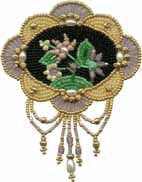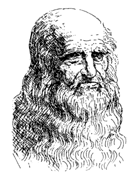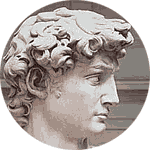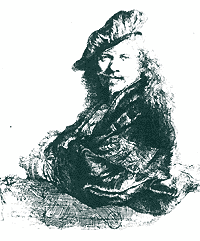|
"Let
each man exercise the art he knows."
Aristophanes - 450 BC-385 BC - Wasps 422 BC
B
baroque
byzantine
D
dali
davinci
E
egyptian
expressionism
G
greek
I
impressionism
M
michelangelo
R
raphael
rembrandt
renaissance
roman
romanticism
S
surrealism
T
timeline
baroque
The Baroque
era stretched from 1600 until the death of Bach in 1750. The
origin of the term baroque comes from the Portuguese and refers
to an 'irregular shaped pearl'. This is indeed an apt
description of the Baroque time period, which included the
production of some of the greatest music of all time, but also
was a time of some of the bloodiest wars in history.
Baroque
society revolved around the idea of the absolute monarchy. The
King or Queen had all-powerful status in their domain as
evidenced by Louis XIV famous line: "I am the State".
The result of this is an increasing separation between classes.
The noblemen rose higher in class to stay with the King, while
the tradesmen created a class of their own: the bourgeoise.
----------
The
Baroque was also the age of reason. Scientific inquiry was at an
all-time high led by the scientific method developed by Isaac
Newton. Scientists were exploring their surroundings, both on
the earth and in the heavens.
The
Catholic Church was fighting back against the humanist tide of
the Renaissance. Led by the Counter-Reformation movement,
intense wars were fought on European soil in the name of
religion. The end result was that England and France emerged as
the major powers in Europe, one Protestant and one Catholic.
byzantine
For more
than a thousand years, until the conquest of Constantinople by
the Turks in 1453, Byzantine art retained a remarkably
conservative orientation; the major phases of its development
emerge from a background marked by adherence to classical
principles. Artistic activity was temporarily disrupted by the
Iconoclastic controversy (726–843), which resulted in the
wholesale destruction of figurative works of art and the
restriction of permissible content to ornamental forms or to
symbols like the cross. The pillaging of Constantinople by the
Frankish Crusaders in 1204 was perhaps a more serious blow; but
it was followed by an impressive late flowering of Byzantine art
under the Paleologus dynasty.
----------
Byzantine
achievements in mosaic decoration brought this from of art to an
unprecedented level of monumentality and expressive power.
Mosaics were applied to the domes, half-domes, and other
available surfaces of Byzantine churhches in an established
hierarchical order. The center of the dome was reserved for the
representation of the Pantocrator, or Christ as the ruler of the
universe, whereas other sacred personages occupied lower spaces
in descending order of importance.
An other
important aspect of Byzantine artistic activity was the painting
of devotional panels, sinci the cult of icons played a leading
part in both religious and secular life. Icon painting usually
employed the encaustic technique. Little scope was afforded
individuality; the effectiveness of the religious image as a
vehicle of divine presence was held to depend on its fidelity to
an established prototype. The development of Byzantine painting
may also be seen in manuscript illumination. Among notable
examples of Byzantine illumination are a lavishly illustrated
9th-century copy of the Homilies of Gregory Nazianzus and two
works believed to date from a 10th-century revival of classicism,
the Joshua Rotulus and the Paris Psalter.
salvador dali
The Spanish
artist, Salvador Dali, is considered one of the most impressive
artists of the 20th century, not only because of his paintings
but also because of his eccentric character. Dali was born in
1904 in Figures, Spain, and nine months after the death of his
older brother, who was also named Salvador. At the young age of
10, Dali first began painting. In 1917, Dali's father organized
an exhibition of his charcoal drawings in their family home. A
year later, in 1918, one of his drawings was published in a
Catalan magazine, Patufet. Dali was also recognized in local
newspapers and the magazine Stadium. In 1921, Dali's mother
passed away.
Having been
already exposed to the artist movement and styles of
Impressionism, Post-Impressionism, and Futurism, he was accepted
to the Academia de San Fernando in Madrid, only to be expelled
in 1926 for refusing to take the examination in "Fine Art
Theory." He stated that the faculty was not competent
enough to examine him. During this time he explored Cubism,
Neo-Classicism, and Realism in his paintings. The year 1929
proved to be an important year for Dali: he made his first
Surrealist Film, Un Chien Andalou with former classmate Luis
Bunuel, joined the Surrealist group, and in June, he met Gala
Eluard, the wife of Paul Eluard, a Surrealist poet. She
eventually became his wife, his muse, and influence behind many
of his paintings. Other inspirational people for Dali were
Picasso, Miro, the architect Guadi, and especially the landscape
of Catalonia.
----------
leonardo davinci
The
illegitimate son of a 25-year-old notary, Ser Piero, and a
peasant girl, Caterina, Leonardo was born on April 15, 1452, in
Vinci, Italy, just outside Florence. His father took custody of
the little fellow shortly after his birth, while his mother
married someone else and moved to a neighboring town.
Growing up in
his father's Vinci home, Leonardo had access to scholarly texts
owned by family and friends. He was also exposed to Vinci's
longstanding painting tradition, and when he was about 15 his
father apprenticed him to the renowned workshop of Andrea del
Verrochio in Florence. Even as an apprentice, Leonardo
demonstrated his colossal talent. Indeed, his genius seems to
have seeped into a number of pieces produced by the Verrocchio's
workshop from the period 1470 to 1475. For example, one of
Leonardo's first big breaks was to paint an angel in Verrochio's
"Baptism of Christ," and Leonardo was so much better
than his master's that Verrochio allegedly resolved never to
paint again. Leonardo stayed in the Verrocchio workshop until
1477 when he set up a shingle for himself.
In search of
new challenges and the big bucks, he entered the service of the
Duke of Milan in 1482, abandoning his first commission in
Florence, The Adoration of the Magi. He spent 17 years in Milan,
leaving only after Duke Ludovico Sforza's fall from power in
1499. It was during these years that Leonardo hit his stride,
reaching new heights of scientific and artistic achievement.
The Duke kept
Leonardo busy painting and sculpting and designing elaborate
court festivals, but he also put Leonardo to work designing
weapons, buildings and machinery. From 1485 to 1490, Leonardo
produced a studies on loads of subjects, including nature,
flying machines, geometry, mechanics, municipal construction,
canals and architecture, designing everything from churches to
fortresses. His studies from this period contain designs for
advanced weapons, including a tank and other war vehicles,
various combat devices, and submarines. Also during this period,
Leonardo produced his first anatomical studies. His Milan
workshop was a veritable hive of activity, buzzing with
apprentices and students.
Between 1490
and 1495 he developed his habit of recording his studies in
meticulously illustrated notebooks. His work covered four main
themes: painting, architecture, the elements of mechanics, and
human anatomy. These studies and sketches were collected into
various codices and manuscripts, which are now hungrily
collected by museums and individuals.
----------
About 1503,
Leonardo reportedly began work on the Mona Lisa. On July 9,
1504, he received notice of the death of his father, Ser Piero.
Through the contrivances of his meddling half brothers and
sisters, Leonardo was deprived of any inheritance. The death of
a beloved uncle also resulted in a scuffle over inheritance, but
this time Leonardo beat out his scheming siblings and wound up
with use of the uncle's land and money.
Leonardo died
on May 2, 1519 in Cloux, France. Legend has it that King Francis
was at his side when he died, cradling Leonardo's head in his
arms.
expressionism
Expressionism
is a style of art in which the intention is not to reproduce a
subject accurately, but instead to portray it in such a way as
to express the inner state of the artist. The movement is
associated with Germany in particular, and was influenced by
such emotionally-charged styles as symbolism, fauvism, and
cubism.
There are several different and somewhat overlapping groups of
Expressionist artists, including Die Brücke, Der Blaue Reiter,
Die Neue Sachlichkeit and the Bauhaus School.
Leading Expressionists included Wassily Kandinsky, George Grosz,
Franz Marc, and Amadeo Modigliani.
In the mid-20th century, abstract expressionism (in which there
is no subject at all, but instead pure form) was developed into
an extremely influential style.
impressionism
Impressionism,
a major movement in painting that developed chiefly in France
during the late 19th and early 20th centuries. Impressionist
painting comprises the work produced between about 1876 and 1886
by a group of artist who shared a set of related approaches and
techniques. Characteristics of this style were an attempt to
accurately and objectively record visual reality in terms of
transient effects in light and color.
Impressionism
is light, spontaneous manner of painting which began as a
reaction against the formalism of the dominant academic style.
Its naturalistic and down-to-earth treatment of its subjects has
its roots in the French realism of Corot and other.
The movement's
name came from Monet's early work, Impression: Sunrise, which
was singled out for criticism by Louis Leroy on its exhibition.
The hallmark of the style is the attempt to capture the
subjective impression of light in a scene.
----------
The core of the
earliest impressionist group was made up of Claude Monet,
Pierre-Auguste Renoir and Alfred Sisley. Other associated with
this period were Camille Pissarro, Edgar Degas, Gustave
Caillebotte, Frederic Bazille, Edouard Manet and Mary Cassatt.
The
impressionist style is still widely practiced today. However, a
variety of successive movements were influenced by it, grouped
under the general term post-impressionism.
michelangelo
buonarroti
Michelangelo
Buonarroti lived from 1475 until 1564. He exerted enormous
influence in the Italian Renaissance. Michelangelo was a
sculptor, painter, architect and poet. He was one of the fouders
of the High Renaissance and, in his later years, one of the
principal exponents of Mannerism. Born at Caprese, the son of
the local magistrate, his family returned to Florence soon after
his birth. Michelangelo's desire to become an artist was
initially opposed by his father, as to be a practising artist
was then considered beneath the stadion of a member of the
gentry. He was, however, eventually apprenticed in 1488 for a
three-year term to Domenico Ghirlandaio.
----------
Later in life,
Michelangelo tried to suppress this apprenticeship, implying
that he was largely self-taught, undoubtedly because he did not
want to present himself as a product of the workshop system
which carried with it the stigma of painting and sculpture being
taught as crafts rather than Liberal Acts.
Nevertheless,
it was in Ghirladaio's workshop that Michelangelo would have
learnt the rudiments of teh technique of fresco painting. Before
the end of his apprenticeship, however, he transferred to the
school set up by Lorenzo the Magnificent in the gardens of the
Palazzo Medici. Here he would have had access to the Medici
collection of antiqued, as well as a certain amount of tuition
from the resident master, Bertoldo di Giovanni. His work here
included two marble reliefs, a Madonna of the Steps, carved in
rilievo schiacciato and showing the influence of Donatello and a
Battle of the Centaurs, based on Bertoldo's bronzo Battle of the
Horseman, which itself appears to be based on an antique
prototype.
In the time
before his death, Michelangelo worked on the tombes of the
Medici's. Pope Clement VIII commissioned him to paint the freso
of the Last Judgement for the Sistine Chapel. Following the Last
Judgement Paul III commissioned from Michelangelo his two last
major frescos for the Capella Paolina, the Conversion of St.
Paul and the Martyrdom of St. Peter. In 1546 Michelangelo was
appointed Chief Architect to the St. Peter and charged with the
completion of the new church. The dome was erected after his
death, to his design but with some modifications. He died on
February 18th, 1564.
raphael
under
construction...
rembrandt van rijn
under
construction...
----------
renaissance
The renaissance
was a period or great creative activity, in which artists broke
away from the restrictions of byzantine art. Throughout the 15th
century, artists studied the natural world, perfecting their
understanding of such subjects as anatomy and perspective. Among
the many great artists of this period were Paolo Uccello, Sandro
Botticelli, Domenico Ghirlandaio, and Piero della Francesca.
During this
period there was a parallel advancement of gothic art centered
in Germany and the Netherlands, known as the northern
renaissance.
----------
The high
renaissance was the culmination of the artistic revolution of
the early renaissance, which began around 1500. and one of the
great explosions of creative genius in history. It is notable
for three of the greatest artists in history: Leonardo da Vinci,
Michelangelo Buonarroti, and Raphael. Also active at this time
were such masters as Giovanni Bellini, Giorgione and Titian.
By about the
1520's, High Renaissance art had become exaggerated into the
style known as Mannerism.
romanticism
Romanticism
might best be described as anti-Classicism. A reaction against neoclassicism,
it is a deeply-felt style which is individualistic, beautiful,
exotic, and emotionally wrought.
Although Romanticism and Neoclassicism were philosophically
opposed, they were the dominant European styles for generations,
and many artists were affected to a greater or lesser degree by
both. Artists might work in both styles at different times or
even mix the styles, creating an intellectually Romantic work
using a Neoclassical visual style, for example.
Great artists closely associated with Romanticism include J.M.W.
Turner, Caspar David Friedrich, John Constable, and William
Blake.
In the United States, the leading Romantic movement was the
Hudson River School of dramatic landscape painting.
Obvious successors of Romanticism include the pre-Raphaelite
movement and the symbolists. But impressionism, and through it
almost all of 20th century art, is also firmly rooted in the
Romantic tradition.
surrealism
Surrealism
is a style in which fantastic visual imagery from the
subconscious mind is used with no intention of making the
artwork logically comprehensible. Founded by Andre Breton in
1924, it was a primarily European movement which attracted many
members of the chaotic dada movement. It was similar in some
respects to the late 19th-century symbolist movement, but deeply
influenced by the psychoanalytic work of Freud and Jung.
The Surrealist circle was made up of many of the great artists
of the 20th century, including Jean Arp, Max Ernst, Giorgio de
Chirico, Man Ray, Joan Miro, and Rene Magritte. Salvador Dali,
probably the single best-known surrealist artist, was somewhat
of an outsider due to his right-wing politics, during this
period leftism was fashionable among surrealists, in fact in
almost all intellectual circles.
The magic realists were American artists somewhat influenced by
the surrealists.
timeline
| era |
style |
artist |
| 1000 |
egyptian |
dipylon vase |
| 400 |
greek |
acropolis |
| 200 |
roman |
nike of samothrace |
| 100 |
roman |
pompei |
| 400 |
byzantine |
pantheon |
| 600 |
byzantine |
lindisfarne gospels |
| 1000 |
romanesque |
bayeux tapestry |
| 1250 |
gothic |
lorenzetti |
| 1400 |
early renaissance |
DaVinci |
| 1500 |
high renaissance |
Michelangelo - Raphael |
| 1600 |
baroque |
Rubens - Rembrandt |
| 1700 |
rococo |
Boucher |
| 1750 |
neoclassism |
Fragonard |
| 1800 |
romanticism |
Gerard |
| 1800 |
realism |
Copley |
| 1850 |
pre-rephaelites |
Rossetti |
| 1850 |
luminist |
- |
| 1875 |
impressionism |
Cassatt - Monet |
| 1900 |
abstraction |
Gorkey |
| 1900 |
fauvism |
Rouault |
| 1900 |
futurism |
Balla |
| 1900 |
dada |
Picabia |
| 1900 |
surrealism |
Dali |
| 1950 |
expressionism |
Ensor |
| 1950 |
pop-art |
Lichtenstein |
|

